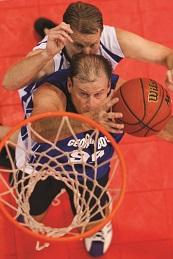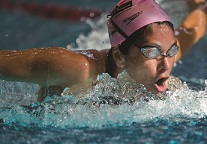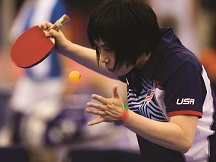

The portion of the U.S. population that has been active throughout its youth and middle age regards its 'senior' status as something other than discounts on movie admission and restaurant rates. For this particular demographic, hitting 50 and moving beyond also means a different age category in athletic endeavors. Simply put, there are more active adults than ever, and they're staying active longer.
Like the individuals who embrace it, this trend shows no sign of slowing down. In fact, in its annual survey of fitness trends, the American College of Sports Medicine consistently ranks fitness programs for older adults in its top 10.
Active aging adults are the reason the National Senior Games Association exists and flourishes. Created in 1985 as a means of promoting healthy lifestyles for adults through education, fitness and sport, this organization today offers the largest multi-sport event in the world for seniors. Its national games are held biennially and involve 19 core sports: archery, badminton, basketball, bowling, cycling, golf, horseshoes, pickleball, racewalk, racquetball, road race, shuffleboard, softball, swimming, table tennis, tennis, track and field, triathlon and volleyball. NSGA Member Organizations around the country hold annual games with qualifying competitions in the year preceding The Games. Athletes who meet specific criteria while participating in the State Senior Games qualify to participate.

Sports Destination Management: What is the biggest challenge in putting on a sports event for seniors?
Marc T. Riker: We have a mix of people, and they range from being what you might consider a novice at their sport to being very proficient. Some people train every day and are very competitive, while some are more casual and social. At this age, fifties and sixties and beyond, you have people who have come to sports for different reasons. Some have been active all along, but some have become active because of a physical condition, or because they just enjoy having an activity to do. As administrators, we are challenged with planning an event that will be enjoyable for those who are interested in turning in their peak performance, as well as those who just want to get out and socialize.
SDM: Does NSGA see a lot of participation from retired professional athletes and does this affect the tenor of the Games?
Riker: We really have a very small percentage of people who are professional athletes. These Games are really geared toward people who are amateur athletes. One of our rules is that if someone was, for example, a professional golfer, meaning that was their primary source of revenue, they have to be at least 20 years removed from doing that if they want to compete in golf at our Games. They could compete in bowling instead or in any other sport, just not in golf until that 20-year time was over.
SDM: Are there special considerations in choosing facilities for senior athletes?

SDM: What does NSGA look for in choosing locations for games?
Riker: As far as the city that is hosting, you're looking at multiple factors. We're evaluating location, potential volunteer base and having a supportive community that could get involved, including financial partners. You're also looking for resources like media coverage and medical coverage. Of course you need the right venues for all your sports. You need lodging and a good network of transportation. You look for what makes a city popular -- you want people to like the general feel of the city because you know they're coming in for reasons beyond the Games. They might want to take in the cultural activities or go sightseeing when they're not competing. We're also looking at the local network of personnel who can conduct the event, and who can help us put on a multi-sport event. There's a lot that goes into putting on these Games, so there's a lot that goes into making a decision about where to hold them.
The first Games were held in 1987 in St. Louis, and were held there again in 1989. They've also been held twice in Baton Rouge. The rest of the cities we've used once, and they are Syracuse, San Antonio, Houston, Tucson, Orlando, Hampton Roads (Virginia), Pittsburgh, Louisville and Palo Alto. This year, we'll be in Cleveland. In 2015, we'll be in the tri-cities area of Bloomington, St. Paul and Minneapolis, Minnesota.
SDM: What else have you learned to offer, that athletes really enjoy?

SDM: Do people bring family members to watch them compete?
Riker: Yes, they do have family that comes along, but something really interesting is that it's not uncommon for us to see two generations participating now. You might see a father competing, and he's 72 or 73, and now his son, who is now 50, is coming along to participate. We have even had occasions where we've had three generations: someone in their 50s, someone in their 70s and someone in their 90s. We have fathers and sons, mothers and daughters, grandchildren -- it creates a really unique perspective.
SDM: Do you think seniors might show up one year as a spectator, and then in a future year, show up as an athlete?
Riker: I believe that does happen. I think people come in to watch their mom and dad compete, and think 'Wow, I am going to go find the local club to participate in that sport and be part of that too.' People see that sports gives you the opportunity to get out, socialize and be part of a group of people with whom you have a common interest.
SDM: What do you think a younger person can get out of the senior games?
Riker: I think it's pure inspiration. You can watch an individual participating in track and field, for example. You'll see them compete in the high jump, and you realize, 'Oh, my gosh, that person is 78 years old and they're able to do that.' You're inspired because of them. We're offering 19 sports here. There's a whole bunch of activities anyone can get involved with -- you can learn to bowl, swim, shoot an arrow; there really isn't a limitation. There isn't a barrier. You go from thinking, 'There's no way I can do that,' to 'There is no reason I can't do that.' You realize you can even do it at a modified pace. It's all about participating and engaging in healthy activities.
